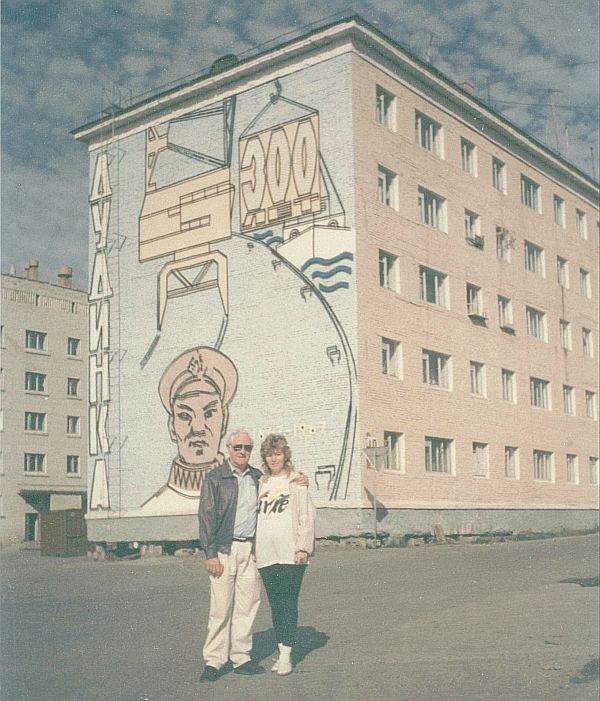The Yenisey River 2-Week Cruise

From 31 July to 1 August 1993
Green Forests, Beautiful Rivers, Stalin's Gulag Ruins,
Million Population Cities -- Siberia Had Them All

Here is the electric train route between Dudinka on the left and Norilsk
on the right
Saturday, 31 July-0105: We arrived at the port city of Dudinka.
The sky at this ungodly hour was still blue. There was no darkness yet, at this
location north of the Arctic Circle.
0530: We were awakened from our sleep. We were told last night
that we would not have breakfast on the ship this morning. Instead, we would
eat after we arrived at Norilsk.
0650: We took a bus from the ship to the train station. We
rode on the world's northernmost railroad.
0712: The train left Dudinka. An electric engine pulled this
train between Dudinka and Norilsk.

The trains are very modern

Note how wide these cars are, Enough for 6 across seating, with an aisle.
There was a diesel engine line that ran from Norilsk north a short distance
to Tainax, a suburb of Norilsk. The passenger cars were just like the ones that
we rode in Latvia and Lithuania. They were very wide. Four persons could sit
on bench seats that were on each side of a center aisle. The coach could easily
seat over 100 persons.
We passed the Dudinka harbor which stretched about 4 kilometers on both sides
along a tributary river that flows into the Yenisey. We went through a huge
railroad shunting and storage area for boxcars of all types. I was a surprised
to see such a large city and harbor perhaps even larger than the port of Long
Beach, California, away up here in the middle of nowhere. Igarka to the south
was a large port, but mainly for Russian oceangoing vessels. Here in Dudinka,
there were oceangoing ships from many nations, even of non Communist countries.
The railroad track was the same gage as the rest of Russia, and built high on
rock footings. At many points along the way, there were snow fences to keep
the winter snows from drifting onto the tracks. At several siding locations,
there were huge diesel and electric locomotives fitted with snowplows and snow
throwing devices.
Most of the rail line was of single track. At each of the stopping points, sometimes
just a road crossing, there were double or triple rows of track for passing
or siding purposes.
The terrain was barren, tundra and dotted with many military installations.
The airport for the area was military, but Aeroflot had daily flights from the
south. Typical of most airfields we had seen along the river, were the three
sectioned phased-array type radar antennae.
The train stopped at the small town of Coercion, where the mosquitos and flies
became a big nuisance. We stopped there for about 30 minutes, while a train
on the single track ahead cleared it.
Our train passed huge diggings where coal was extracted by huge tracked scraping
machines. Much of this coal was moved in pipes laid over the ground to the furnaces
at the steel and copper mills near Norilsk.
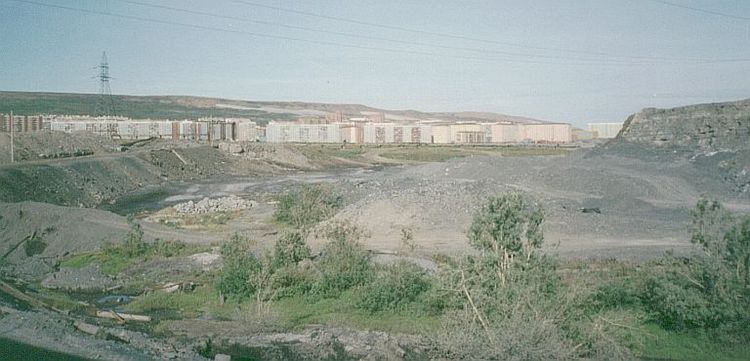
Scene looking from the train over huge digging area with large housing area in background
1015: We arrived at the Norilsk train station. The station
was a large building much as you might find in any medium sized city in Europe.
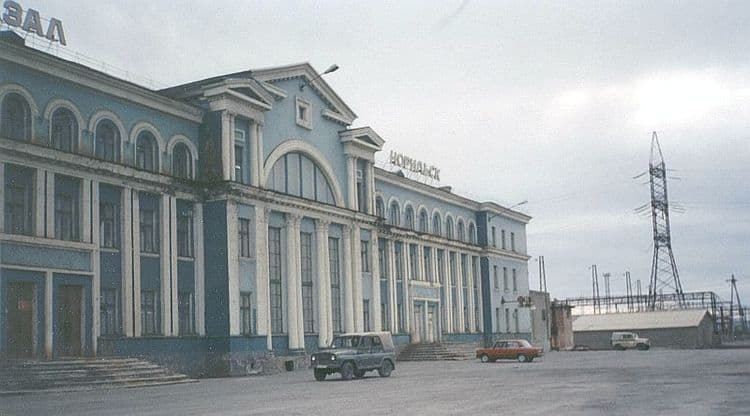
The terminal train station in Norilsk
Another surprise was the extent of the train marshaling yards here, the factory
areas surrounding the housing units of the city, and the buildings within the
city.
All these years I thought Siberia was a wasteland, loaded with Soviet prison
communities and the like. Here, way out in the middle of nowhere, Norilsk was
connected to the world by a railroad line to the river Yenisey at Dudinka. There
were no roads.
This was a city of 1.5 million people. It had large apartment buildings made
of concrete. All of its streets were wider than normal, and were covered with
asphalt. All the streets had wide sidewalks for pedestrians. The main street
had flower dividers down the middle, and was closed to vehicular traffic on
Saturdays and Sundays.
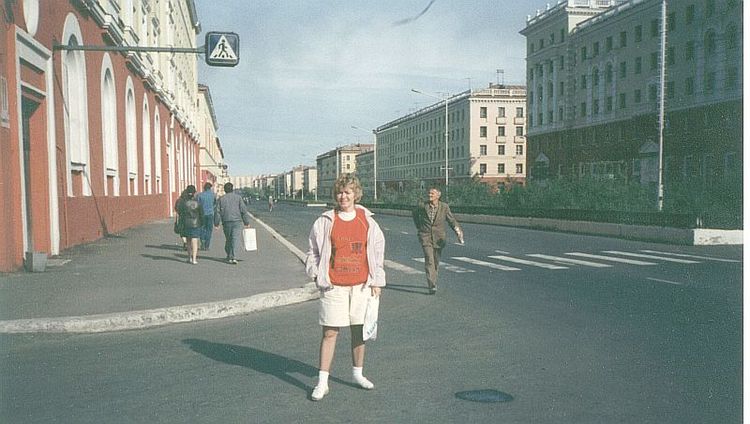
The wide divided main street in Norilsk, with flowered center divider
There were trams (streetcars) on their own rights-of-way, and many bus lines
including the accordion type buses.
The main street was over 2 kilometers long and each building along the way was
about 6 floors high. Stores of all types were on the ground floor. Remember,
because of the permafrost the ground floors of these building were all about
3 or 4 feet above the ground.
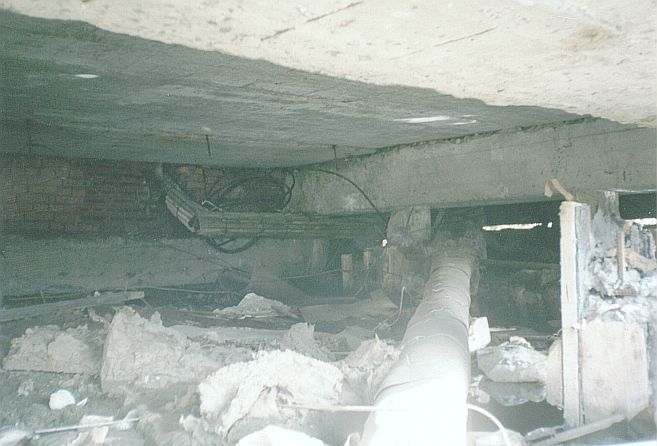
Here is view beneath the first floor showing construction to keep the heat of the building from melting the permafrost underneath
1100: We had breakfast in a large government first class restaurant
right on the main street across from the main theater.
1130: We returned to the buses to begin our city tour. We were
driven around the city and shown the type of housing available. At one stop,
we got a chance to look at the smoke belching from the steel mills. These were
located outside the city at the foot of a mountain.
The guide pointed to a small building on the side of the hill. She explained
that Stalin had a slave camp there. The workers from this camp were lead into
the mines within the mountain . They worked long hours, with little food, and
often died in just a short while after arrival. After Stalin died, the camp
was abolished and the city began to expand. Workers were brought from all over
Russia with promises of better wages and free vacations to the Black Sea. It
worked judging by the 1.5 million people now here. She also noted that just
before the collapse of the USSR, plans were underway to replace the smoke belching
equipment with better controls for the environment. In the colder weather, water
was pumped in and around the furnaces and then piped into the housing units
for heat.
After driving around the city, the bus dropped us at a museum showing scenes
and artifacts of the animals, the forest, the tundra. There was also a large
area devoted to the gulags of Stalin. They had pieces of fencing, gates with
bars, furniture and bed items, and miscellaneous personal items of prisoners.
After visiting the museum, we were taken to an art gallery. They had more to
sell than to show.
Back on the bus, we went outside the city into the tundra, north into a large
mosquito infested area where we saw one of their summer resort camps. The one
we walked around was not much different from a small campsite found in the mountain
towns of the US. Only difference, there were a central kitchen and eating area.
There was no running water in the cabins. The toilets were outside, with no
plumbing. The inside of the cabins looked comfortable with separate rooms for
the kids and adults.
1530: The bus returned us to the restaurant where we had lunch.
It was typical of that aboard the ship.
1600-1800: After lunch we were free to walk around the city
as we pleased. There had been a noticeable lack of militant authoritarian police
activity. Crime was nonexistent. The problems of Moscow were not here. You know
the stories. KGB and other police lurked from dark cars or followed you as you
walked about. Hoodlums or "Mafia" stalked and robbed visitors. Never during
this trip did we ever feel threatened either by the police or possible criminals.
We had always tried and were successful in blending into the community and life
of the locations we visited. So, too, here we looked just like anyone else walking
the streets.
We stopped in many stores along the two kilometer walk to the other end of the
main street. We saw an Opteka (Optics) shop, went in, and showed the clerk Danuta's
eyeglass prescription. Bad news, it would take two weeks to get a pair of glasses
back. So, instead we bought two sets of lenses for her prescription and two
different frames. The frames were 518 Rubles and the lenses were 90 Rubles.
That came to 30 cents for each pair of glasses. In the US we would pay upwards
of $90 for one equivalent set. We also bought beer and soft drinks for 2050
Rubles.
1800-1830: The buses arrived to take us to the train station.
They were not the same tour buses as before. This time they had normal buses
that were too small for the whole group, so some had to stand. The trip was
short. We passed the housing area, and many factories that worked with steel
and copper products. As usual, we arrived in plenty of time to wait and wait.
1926-2246: Per the timetable, our train left right on the dot.
We again stopped for half an hour at the town of Coercion. Before the train
left, we swatted about fifty or so mosquitos that landed on the window and wall
of our car. It wasn't until we had been gone about 45 minutes that we killed
the last one.
We returned to Dudinka over the same route, single track of course. We saw the
same locations as on our trip to Norilsk. But, now many locations where people
were living, supposedly in the middle of nowhere, made more sense after visiting
the museum in Norilsk.
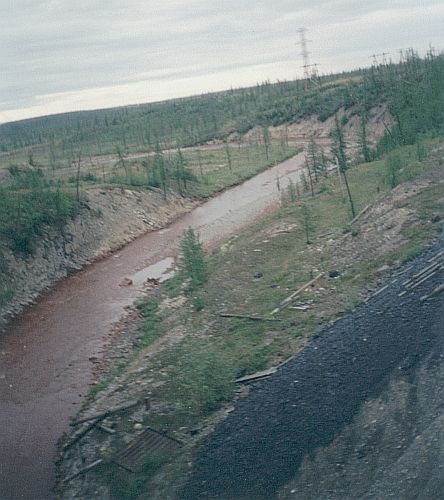
A flowing stream along the tracks
A young girl sitting in the seat behind me heard Danuta and me talking in English.
Finally she got up enough nerve to ask me if I were English. I told her no,
that I was an American. Oh, was she ever excited. She tried to talk to me in
English. She was in her third year of English in school. I asked her about how
many Americans she had seen. I was the first. She said that only Russians and
east block persons ever came to Norilsk. She said that she goes to Dudinka to
stay with her grandmother for a week or two in the summer. There she sees many
foreigners who come with the ships to the port.
2300: Finally, we got back on board ship . Fully exhausted,
we dropped off to sleep.
Sunday, 1 August-0930: After our normal wake up call and breakfast,
we awaited the arrival of the buses that would take us on a brief tour of Dudinka.
Because of the high water flowing during the spring, the dirt road from our
floating dock to the first paved road was about 3 kilometers. Our bus was not
well sealed and the dust poured in to the point that it was difficult to breathe.
Finally we hit the pavement and the dust blew out.
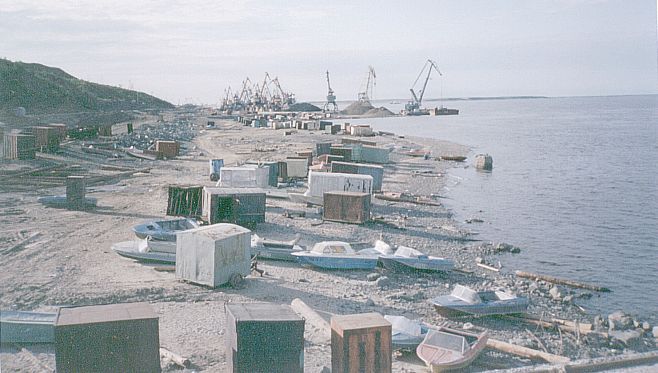
The shore area looking from the ship along the dirt path to the city of Dudinsk
The bus drove us up to the top of a hill on which was located a large apartment
building. It contained a very nice ethnic museum. It showed the history of this
region in dioramas, photos, and of course artifacts of the gulags. The souvenir
stand sold us a sheet of lapel pins for $2. This was only the second time, Igarka
was the first, that we could use US$ to purchase something. Everyplace else
would only take the new 1993 dated Rubles.
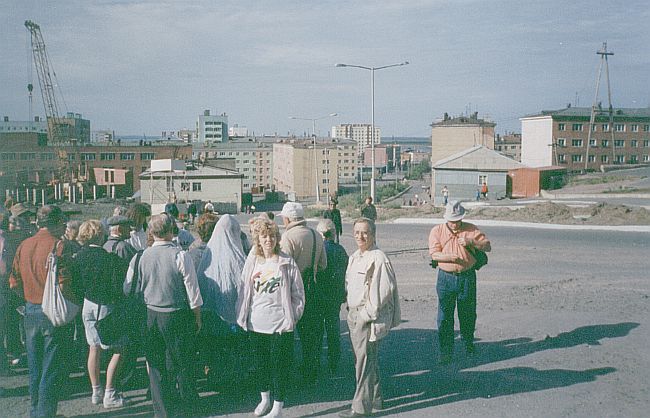
From the top of the hill looking back over the city of Dudinka
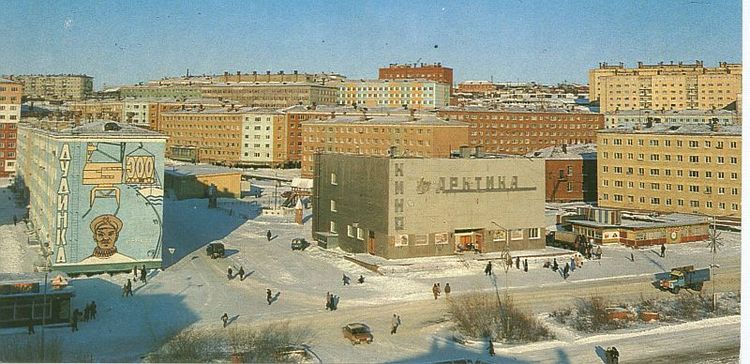
Take a look at this very large city, Dudinka, way up in northern Siberia
Lester & Danuta in front of the building shown in other photo
above.
The one kilometer walk back to the bus pickup point was all downhill. This was
Sunday and all the stores except those selling snacks and foods were closed.
We stopped by a small flea market and looked at the goods and foods. Then I
noticed men coming from a building with a container filled with beer. Aha! I
thought this must be beer from the tap. So, I went close and saw that it was
only a store to fill your own container and leave.
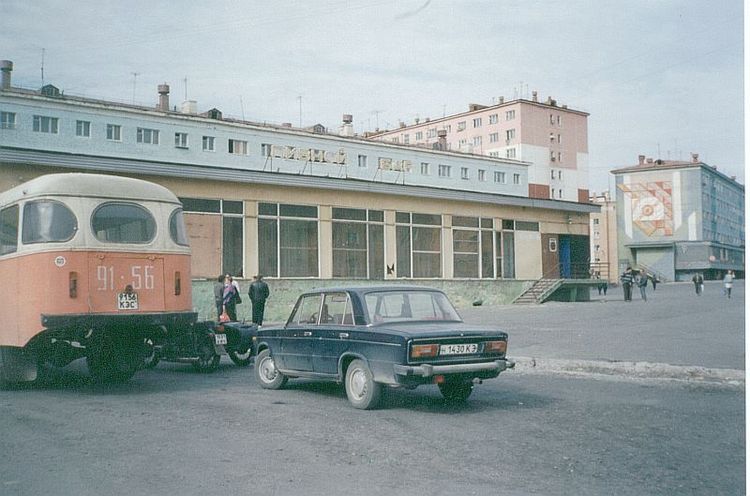
Location of the combination beer hall and supply house as described
Curiosity got the better of me, so I dragged Danuta into another door. There
was a room filled with tables and chairs and just a few noisy beer drinkers.
I lead Danuta to a table and then I tried to find a waitress to serve us. A
customer came to my aid and flushed out the somewhat hefty waitress. I indicated
I wanted a pitcher (1 liter) of beer, which she brought with two glasses. The
cost 120 Rubles (12 cents). As we drank, we noticed that Danuta was the only
woman customer in the place.
When our glasses were about half empty, a man from another table came over and
placed a pitcher of beer on the table next to Danuta, and left. We did not know
what to make of it. Danuta told me not to accept it, one pitcher of beer was
enough.
It wasn't long before that same man, inebriated, came to our table, and sat
on the chair next to Danuta. He began to come on to her, in a way that made
Danuta a little nervous. I could see that the hefty waitress was standing nearby,
her eyes glued to the intruder. Danuta finally turned to me and said that we
should leave. We slowly got up, smiled at the man, said goodbye, waved at the
waitress and left. Outside, Danuta appeared obviously upset over the event.
I, too, was a little worried at the time that something might happen. After
all, here was this older looking dude (me), with a very beautiful young woman,
obviously my daughter, available for dating. So the man probably thought. Anyway,
it was an experience that gave us something to talk about on our way to the
bus stop.
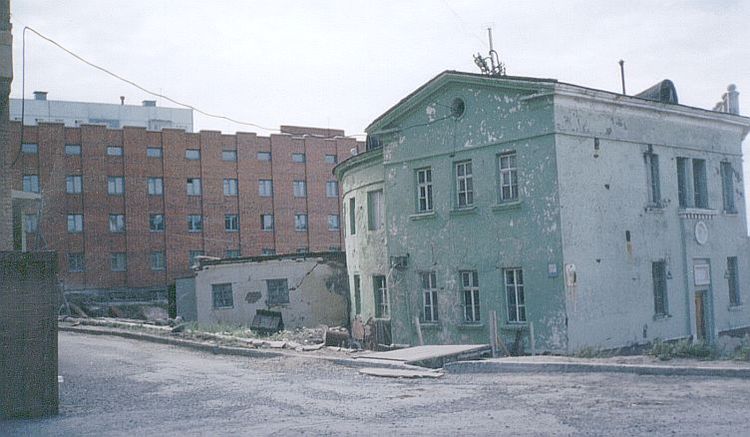
Street scene Dudinka
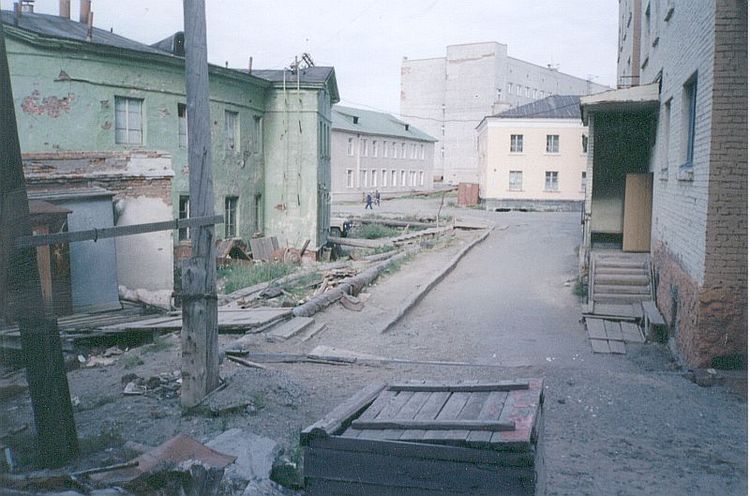
Another street scene Dudinka
1300: The buses arrived to take us back to the ship, again
along the long dusty road.
 Return to Introduction |
 Return to Part 2 |
 Continue on now to Part 4 |













